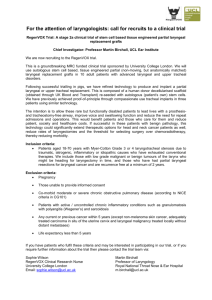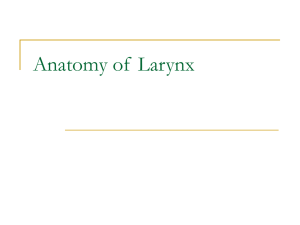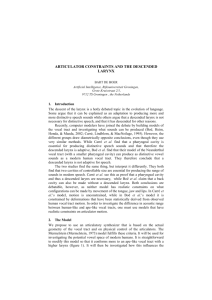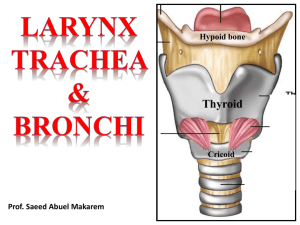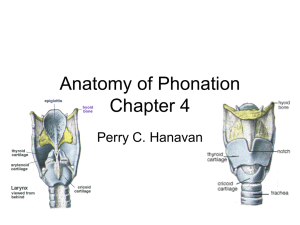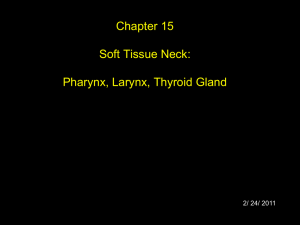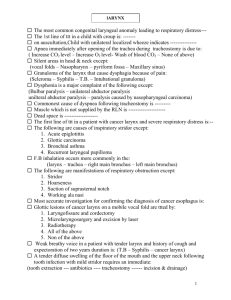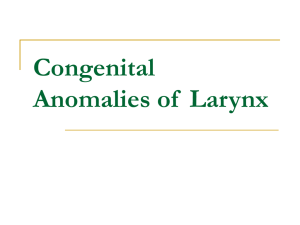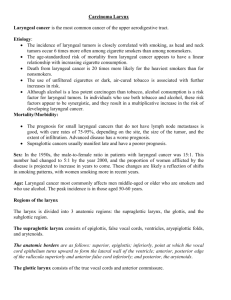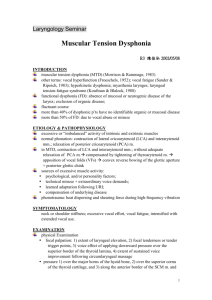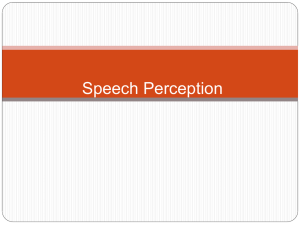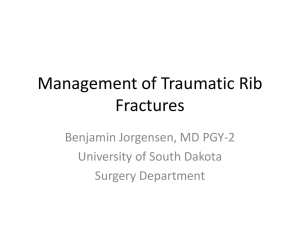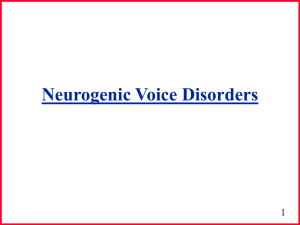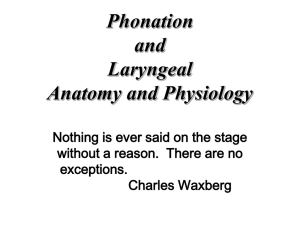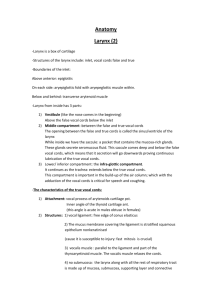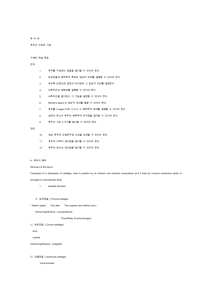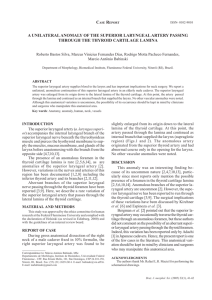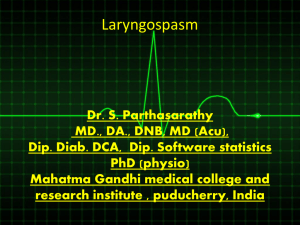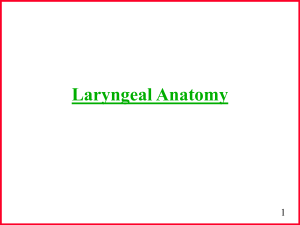Lessac-Madsen Resonant Voice Therapy-KIDS
advertisement
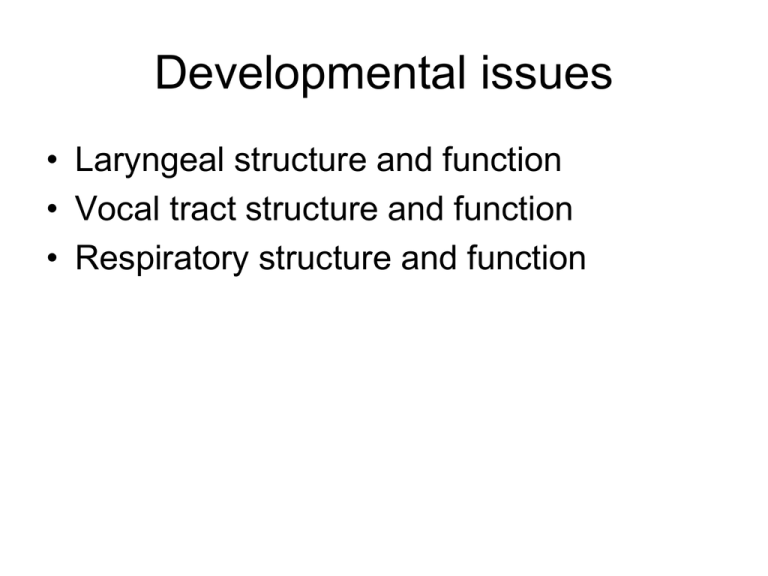
Developmental issues • Laryngeal structure and function • Vocal tract structure and function • Respiratory structure and function Premise • As SLPs, we “operate” on the larynx and other phonatory structures • Therefore knowledge of developmental issues in these structures is important Laryngeal structure (and vocal tract) • Neonatal compared to adult: – – – – – – – – – Pharynx short Cricoid cartilage is high (C4) Tip of the epiglottis is high (C1) Approximation of epiglottis and soft palate thought to allow sucking and simultaneous respiration Hyolaryngeal area is compact Age 2: Lower border of larynx descends to C5 Age 6: Lower border of larynx descends to C6 Age 15: Lower border of larynx descends to final position C6-7; thyroid cartilage and hyoid bone separate during descent Epiglottis: Increases curvature until age 3, then gradually flattens • Isaacson, 1996 • Implication: Vocal tract – source interactions will vary with age; details not well studied Laryngeal structure • Neonatal vs adult, cont’d • Implication: Care in interpretation of images – Aryepiglottic folds thick and bulky – Arytenoids appear prominent – Glottis is 7 mm AP and 4 mm lateral – Isaacson, 1996 Laryngeal structure • Neonatal vs adult, cont’d – Collagen: About 51% of the collagen found in adults (Hammond et al., 2000) – Elastin: About 23% of the elastin found in adults (Hammond et al., 1998) – Differentiation of superficial and deep layers of the lamina propria not present (no ligament) (Ishii et al., 2000) • Image from Gray, 1996 • Implication: Anatomical basis for high pitches in babies? Possibly greater cushioning on VF impact? However, might injury to the BMZ in childhood show up as predisposition to clinical entities later? (Gray, personal communications) Laryngeal structure • Neonatal vs adult, cont’d – Hyaluronic acid (glycosaminoglycan; “cushioning”): actively produced in the maculae flavae of infants – Sato et al., 2001 • Implications: Infant larynx may be protected from phonotrauma due to high proportion of HLA? Laryngeal structure • Neonatal vs adult, cont’d – Fibroblasts: Mostly oval in newborns and spindleshaped in adults. Inactive in producing fibers in newborn. – So fibroblasts and macula flava may contribute to development of ligament over time. – Hirano et al., 1999 • Implications: Infant larynx may be protected from phonotrauma by reduced rate of fiber formation Laryngeal structure • Children, development – Age 5: Dense area seen in the anterior and posterior maculae flavae; longitudinal fibers found between the maculae. – Age 10: Differentiation of superficial versus deep layers of the lamina propria – Age 17: The layered structure of the lamina propria is complete around 17 years of age. – Ishii et al., 2000 Laryngeal structure • Neonatal vs adult, cont’d – Overall implications: Some critical differences between architecture of the lamina propria in infants versus adults may result in protective mechanisms for infants – Evolutionary issues Laryngeal structure • Child, cont’d • Prepubertal vs pubertal larynx, male and female (ages 9-18; Kahane, 1978) • Angle of the thyroid cartilage decreases in boys with age; therefore the relative posterior glottal gap is reduced, compared to the relative gap in females • PGG is thought to contribute to the biomechanics of impact stress, greater in females (women; e.g. Morrison & Rammage, 1993) Laryngeal function • Summary • Infant vocal folds may have protection against phonotrauma • Risk may increase with time from infancy • These speculations match clinical observations Vocal tract structure • Dimensions increase • Formant frequencies decrease • Implications: Sourcefilter interactions change quantitatively • Details not well worked out specifically for children Vocal tract/articulatory function • Ages 1-6: Changes in coordinative relationships of articulators – Young children: Jaw predominated – Older children: Increasing independence of upper and lower lip; increasing use of lip movement for bilabial closure – Green et al., 2000; Green et al., 2002 Vocal tract/articulatory function • Ages 1-6: Changes in coordinative relationships of articulators – Young children: Jaw predominated – Older children: Increasing independence of upper and lower lip; increasing use of lip movement for bilabial closure – Green et al., 2000; Green et al., 2002 • Implication: Evidence is seen of increasing differentiation in motor control – Is one implication that very young children may have difficulty differentially altering voice independent of articulation, reducing a benefit of voice therapy? – Or it is possible that voice therapy would need to take into account this coupling in some as yet unclear fashion? Respiratory structure • • Decreasing compliance of rib cage Changes in general shape and orientation of rib cage • Papastamelos et al., 1995; Sharp et al., 1970 • Toddlers – Rest breathing: • Paradoxing in inspiration (collapse of chest), probably due to high rib compliance (Gaultier et al., 1987) • Toddlers to children – Rest versus speech breathing (15 mo): • Rest: Relative synchrony between rib and abdomen • Speech: Oppositional movement between rib and abdomen in speech breathing – Variability: • Large intra- and intersubject variability (5 wk to 1 yr; 1 yr to 3 yr) » Moore et al., 2001; Boliek et al., 1996, 1997) Respiratory function • Toddlers and children (948 mo) – Increasing independence of rib and abdomen during speech (not rest) breathing (coupling decreased 15% over 3 yr) – Increasing rib expansion in speech (7% over 3 yr) – Increase in oppositional movement of rib and abdomen, possibly favorable biomechanically – Changes were gradual, suggesting attribution to structural changes, not motor control changes » Moore et al., 2004 • Implication: With age, increased capability to generate increasing Ps, and thus increasing VF impact stress?? – E.g. Jiang & Titze, 1994 Summary • Molecular changes in VF structure may increase potential for phonotrauma with age, after infancy, in children (hyaluronic acid; fiber generation; lamina propria differentiation) • Macroscopic changes (relative PGG) may be further protective against phonotrauma in the male larynx with increasing age • Decreases in rib cage compliance and increasing oppositional movement of rib cage and abdomen, to stabilize (and increase?) Ps, may further increase potential for phonotrauma with age, after infancy, in children Summary • Stated differently, from a basic science perspective, children appear to have greater risk of phonotrauma with advancing age • This result seen clinically as well Final note • Target of barely ad/abducted VFs appears relevant for children as goal of therapy, as for adults – Preliminary data, D.A. Berry, personal communication
